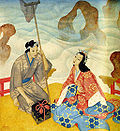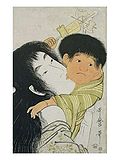- Hoichi the Earless
-
Hoichi the Earless (耳なし芳一 Mimi-nashi Hōichi) is a character from Japanese mythology. His story is well known in Japan, and the best-known English translation first appeared in the book Kwaidan: Stories and Studies of Strange Things by Lafcadio Hearn.
A version of this story appears in the film Kwaidan, as well as the play The Dream of a Summer Day, which are both based on Hearn's work. Hoichi the Earless is closely associated with Akama Shrine in Shimonoseki, as his story takes place at the Buddhist temple Amidaji, which preceded the shrine before Shintō became the state religion of Japan.
Legend summary
According to legend, Hoichi was a blind minstrel (or biwa hoshi) with amazing gifts for the biwa (a loquat-shaped Japanese lute). He was particularly good at performing the Tale of the Heike, an epic describing the fall of Emperor Antoku, who is buried at Amidaji Temple. His performances were so wonderful that "even the goblins could not refrain from tears." Despite his talents, Hoichi was very poor and was forced to live at Amidaji Temple with a friendly priest.
As the story goes, Hoichi was approached late one night by a gruff samurai who demanded that the minstrel play for his lord. The retainer led the blind Hoichi into what appeared to be the home of some powerful nobleman, where a performance of the Tale of the Heike was requested. Hoichi's performance was met by high praise and moved his audience to tears, and he was asked to return the next evening for a follow-up recital. Before the retainer returned him to his temple, Hoichi was told that the nobleman for whom he had been playing was traveling incognito, and was warned not to speak of the evening's events.
The following evening, the samurai returned to Hoichi's quarters and led him back to the nobleman. However, this time Hoichi's absence was discovered by his friend, the priest of Amidaji Temple. The priest grew suspicious and instructed his servants to look after Hoichi the next night. When they saw him leaving the temple the servants gave chase and eventually found Hoichi playing his biwa furiously in the middle of the Amidaji cemetery. When they dragged him back to the temple, Hoichi explained the previous night's events to the priest.
Realizing that Hoichi had been bewitched by ghosts, the priest vowed to save his friend from further trickery. He painted Hoichi's body with the kanji characters of the Heart Sutra for protection and instructed him to remain silent and motionless when he is called upon by his ghostly audience. That evening the samurai called for Hoichi as before, and was angered when he received no response. The ghostly samurai approached Hoichi but was unable to see anything but his ears. The sutra had rendered the rest of Hoichi's body invisible. Attempting to comply with his orders, the samurai ripped Hoichi's ears off as proof that they had been the only portion of the lute player that was available.
After the ghostly retainer had left, Hoichi was still too frightened to react, despite the blood gushing from the wounds on his head. When the priest returned, he realized in dismay that he had neglected to write the sutra on Hoichi's ears, which had left them vulnerable to the spirit. Despite his injury, Hoichi's ordeal had freed him from the spirit's power, and he went on to recover from his wounds and become a famous musician.
See also
External links
- Kwaidan: The Story of Mimi-nashi-Hoichi - Translated by Lafcadio Hearn
- The Story of Mimi-nashi-Hoichi (Japanese)
- Earless Hoichi at Akama Shrine - A photo of Hoichi with his biwa at Akama Shrine.
Japanese folklore 
Folktales 
Text collections Legendary creatures Categories:
Wikimedia Foundation. 2010.


